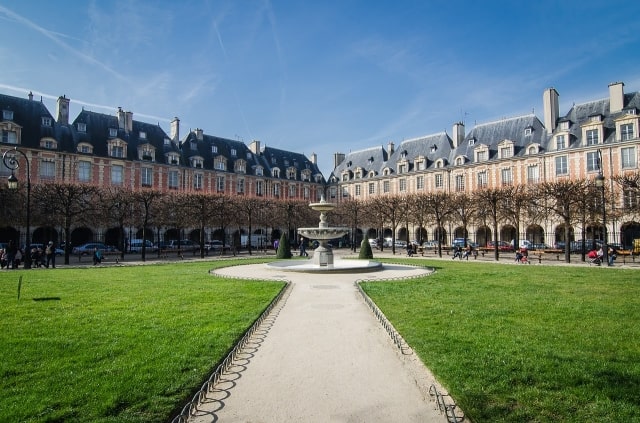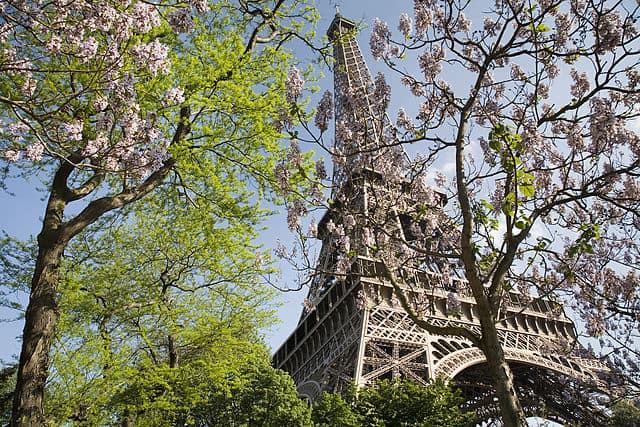Quick History of Parisian Architecture
Parisian architecture is synonymous with the city. It’s hard to deny that those uniform grey rooftops, wrought iron around the balconies, and nearly identical façades represent the Paris that we all know and love. All of these features may jump out as Parisian today, but like many things in the city, it hasn’t always been this way!
In fact, the Paris of yesteryear was dirty, crowded, polluted, and filled with a hodgepodge of different architectural styles. Interested in finding out how the French capital went from a medieval city to the one we see today. Keep reading for a (very) quick history of Parisian architecture!
The Middle Ages
It’s best to start at the beginning, and although Paris was conquered by the Romans in 52 BC, for the sake of time I’m going to be starting my history with the Middle Ages. However, on a side note, if you’re interested in checking out some Gallo-Roman architecture in the city, you should definitely check out the Arènes de Lutèce, which is an open-air amphitheater that dates back to the 1st century AD. Just sayin’.
There are several architectural beauties of the Middle Ages that have remained standing in Paris. You’ll find most, if not all, of them on the Île de la Cité, which is one of the islands in the center of Paris on the Seine River. A few of note are:
- The Palais de la Cité: The palace that housed the king of France from the 6th-14th centuries. Then, from the 14th century to the Revolution, it housed the treasury, judicial system, and the Parliament of Paris. Today, it’s referred to as the Palais de Justice and houses the Court of Appeal of Paris.
- The Sainte-Chapelle: A former royal chapel which boasts the most extensive collection of 13-century stained glass windows in the world.
- The Conciergerie: A former prison that once housed Marie-Antoinette during the French Revolution. Today it holds law courts.
The Middle Ages also welcomed the first Gothic-style churches in Paris. The Notre-Dame, Sainte-Chapelle, and Tour Saint-Jacques all still remain in the city and are great places to go to admire this style of architecture.
You’ll find other remains of the middle ages in Le Marais and the area around the Châtelet metro station. One in particular that I find fascinating is the former home of Nicolas Flamel, the supposed alchemist. His former abode, built circa 1407, is the oldest house in Paris!
The 17th century
Fast forward several hundreds of years to the 17th century Renaissance style ruled in Europe at the time and Paris was no different! The city had queen and benefactor Marie de’ Medici to thank for the influx of improvements. The Louvre was expanded, and a different type of style came all the way from Italy called the “Baroque.” The style was characterized by opulence and Parisians adored the new over-the-top architecture that came along with it.
Royal and public squares also became the rage at this time, and several of them can still be seen in the city:
- The Place Dauphine: A public square located at the end of the Île de la Cité, which connected to the newly completed Pont Neuf.
- The Place Royale (now the Place des Vosges): Located in Le Marais and completed in 1612, this place is the oldest in the city. The square was a fashionable place to live in the 17th and 18th centuries and honestly, not much has changed! Don’t miss Victor Hugo’s home, which is located on the square.
The 17th century also welcomed the debut of the dome, which can be seen on buildings throughout the city as well. Les Invalides, the chapel at La Sorbonne, and the Institut de France are just a few!
Napoleon III and Baron Haussman
Fast forward another few hundred years again. Hey, I told you this was going to be a quick history! The French economy was thriving under the rule of Napoleon III, and he wanted to renovate the capital in order to reflect it. Alongside Baron Haussmann, the prefect of Seine, Paris was to be completely upheaved and reinvented.
The pair wanted to get rid of the cramped and crowded medieval streets that filled Paris and install wide boulevards that would be lined with residential buildings. On the one hand, Paris did need to be cleaned up and renovated. The poor and working-class were living in squalid conditions across the city and these conditions were causing disease and death to run rampant.
While their changes did improve the city, the move is sometimes criticized as Napoleon and Haussmann essentially kicked hundreds of thousands of Parisians out of their homes and didn’t really do much to ensure that they could find housing elsewhere.
This major change also set up the system of quarters in the city, known in French as arrondissements. There are 20 arrondissements that emerge from the center in a spiral pattern. The pattern is lovingly dubbed “the snail” which goes along nicely with one of the most famous dishes in French cuisine, escargot!
The influence of the Universal Expositions
The Universal Exposition, or the World’s Fair, was once a very big deal across the world. It occurred every 5 years (sometimes more often), and Paris hosted the event quite often, once for 7 years in a row.
Countries came from all corners of the world to put their accomplishments on display. This came in the form of architectural improvements, culinary achievements, their latest inventions, and more.
A lot of the exhibits were meant to be temporary, and several were in fact torn down after the exposition was over. But, there were some that were left standing that you can still see today:
- The Petit and Grand Palais: Two beaux-arts style buildings built with impressive iron and glass work in the 1900 Universal Expo. Today, both are museums.
- The Eiffel Tower: The symbol of Paris! Believe it or not, the Eiffel Tower was meant to be torn down after the 1889 edition. It was saved when someone had the bright idea to use it as a radio tower after the Exposition was over.
- The Pont Alexandre III: Another gem from the 1900 Exposition, this bridge features a 6-meter high single span steel arch which was unheard of at the time!
Conclusion
Since the Universal Expositions in the 19th and 20th centuries, there have been many other iconic buildings constructed in Paris. Modern marvels like the Centre Pompidou, the Montparnasse Tower (although most Parisians can’t stand it), La Défense, and the Louvre Pyramid come to mind. Make sure you don’t miss them when you visit the city!
There are several architectural wonders to be seen in Paris today. I hope you’ve enjoyed this very quick history of Parisian Architecture! And, if you’re in the French capital and want to learn even more, hop on a walking tour with one of our expert guides. Click here to learn more and make a booking!
Planning a trip to Paris ? Get ready !
These are Amazon’s best-selling travel products that you may need for coming to Paris.
Bookstore
- The best travel book : Rick Steves – Paris 2023 – Learn more here
- Fodor’s Paris 2024 – Learn more here
Travel Gear
- Venture Pal Lightweight Backpack – Learn more here
- Samsonite Winfield 2 28″ Luggage – Learn more here
- Swig Savvy’s Stainless Steel Insulated Water Bottle – Learn more here
Check Amazon’s best-seller list for the most popular travel accessories. We sometimes read this list just to find out what new travel products people are buying.














